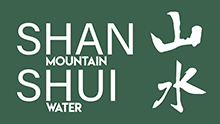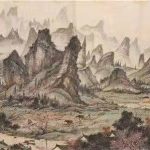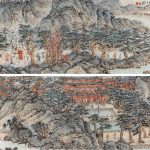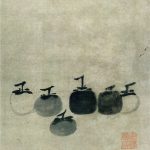Reclusive culture in Mountain and Water painting
the article has been part of the interventions of the 27th -29th November 2020 conference: The Annual Kurultai of the Endangered Cultural Heritage – AKECH 3rd edition; The Annual Lecture on Exile in Comparative Literature and the Arts – ALECLA 3rd edition
Issue 2 – By; Giacomo Bruni
Origins of the Reclusive culture
Reclusive culture yinshi wenhua 隐士文化 is an important branch of Chinese traditional culture with distinctive characteristics and far-reaching influence, till the contemporary times. The reclusive culture has basically taken shape in the pre-Qin period, in particular in a historical phase that includes the period of Springs and Autumns 春秋時代 Chunqiu shidai (722-481) and of the Warring States 战国 Zhanguo (453-221). The latter was a period of violence, characterized by political and social instability, but also of great cultural richness and creativity, which led to the birth or theoretical formalization of the many currents of thought, giving light to the Hundred Schools of Thought 诸子百家 Zhuzi baijia, of which Confucian and Daoist will become fundamental pillars of Chinese culture. Since this historical moment there are relevant records of hermits 隐士, both from Confucian and Daoist sources, characters such as Chang Ju 长沮 and Jie Yong 桀溺 in the Confucian classics the Analects of Confucius, Lunhua 《论语》 and in the Taoist classic Zhuangzi 庄子, there are fables of reclusive people who cherish Daoism, such as Xu You 许由 and Shan Juan 善卷, who rejected the throne for a simple and carefree life. At a time when taking up a government post could be a dangerous choice for one’s own safety, retirement from social life became a choice by the intelligentsia of the time. Even in the Confucian context, where social participation was one of the fundamental aspects of the intellectual’s life, the choice of the hermitage was accepted, naturally always following the teachings of Confucius, therefore for the purposes of self-cultivation, ethically and morally, but always with the idea of returning to participate in socio-political life with a deep commitment of social responsibility. Otherwise, the Daoist hermit, while always having the purpose of self-cultivation, saw the secular world as a world from which to move away, in order to enter into a relationship of communion and contact with nature, developing the most intimate aspects of his personality, preferring spontaneity, therefore acting free from utilitarianism. This vision also includes the Daoist concept of wuwei 无为, or acting without effort, from which the topical association with water was born, which has no shape, has complete freedom of movement and despite being weak it can erode the stone. Concept close to that of carefree wandering, xiaoyao you 逍遥游, conceived by Zhuangzi himself, a carefree existence requires goal-free wandering, only by forgetting the boundaries of the object and self, reaching the realm of selflessness, futility and anonymity is possible to reach the real “carefree travel”.
One of Zhuangzi’s Daoist tales in the section of 《秋水 – The Floods of Autumn》 tells us:
Zhuangzi was (once) fishing in the river Pu, when the king of Chu sent two great officers to him, with the message, ‘I wish to trouble you with the charge of all within my territories. Zhuangzi kept on holding his rod without looking round, and said, ‘I have heard that in Chu there is a spirit-like tortoise-shell, the wearer of which died 3000 years ago, and which the king keeps, in his ancestral temple, in a hamper covered with a cloth. Was it better for the tortoise to die, and leave its shell to be thus honored? Or would it have been better for it to live, and keep on dragging its tail through the mud? ‘ The two officers said, ‘It would have been better for it to live, and draw its tail after it over the mud.’ ‘Go your ways. I will keep on drawing my tail after me through the mud. ‘(Legge, 1891)
庄子钓于濮水,楚王使大夫二人往先焉,曰:「愿以境内累矣!」庄子持竿不顾,曰:「吾闻楚有神龟,死已三千岁矣,王巾笥而藏之庙堂之上。此龟者,宁其死为留骨而贵乎,宁其生而曳尾于涂中乎?」二大夫曰:「宁生而曳尾涂中。」庄子曰:「往矣!吾将曳尾于涂中。」 《庄子-外篇- 秋水》
This episode in addition to illustrating the character of the hermit who moves away from the burdens and honours of secular life, describes Zhuangzi while fishing, which clearly recalls the figure of the fisherman who will become of great importance in the panorama of reclusive culture. The fisherman, a solitary figure closely linked to water, is the natural hermit, so his vision of the world and lifestyle is the one to follow. In 《楚辞 – Chu Ci》, a text traditionally attributed in part to Qu Yuan 屈原(c. 340-278), a Chinese poet and politician who lived during the Warring States period, relates an episode when the exiled Qu Yuan complains with a fisherman of the secular world:
The fisherman: “Sages do not cling to things, but can move on with the world. The world is turbid, why don’t you stir up the mud and spread the waves.” (Legge, 1891)
渔父曰: “圣人不凝滞于物,而能与世推移。 世人皆浊,何不淈其泥而扬其波?《楚辞 · 渔父》
Qu Yuan then replied him, but the fisherman goes away singing and smiling without answering. This episode illustrates the wisdom of the fisherman who finds no interest in the affairs of the secular world or in complaining about it. The same can be said of the figure of the mountaineer/woodcutter 樵夫 qiaofu, who, like the fisherman, spends his life in the isolation of the mountains surrounded by nature, giving no importance to the secular world. The figure of the fisherman and the woodcutter will acquire a great deal of importance in the imaginary of reclusive cultures, so much so that they become topical figures.
Reclusive culture and the rising of mountain and water painting
In 221 BCE the phase of instability ends with the establishment of the Qin empire 秦朝, which after only 15 years will be replaced by the Han dynasty 汉朝 (202BCE-220CE), which will be in power for about 400 years, apart from a brief interruption from 9 to 23 when the Xin dynasty 新朝took over. These four centuries of Chinese history were characterized by a Confucian-based ideological setting, which as we have said gave great importance to the political and social participation of the individual, therefore the ideals of the reclusive culture, but also more generally the Daoist teachings became minorities in the intellectual scene of the time. Things began to change in the years of the decline of the Han dynasty and after its fall, when a situation of instability and violence due to conflicts returned, there was a revival of the Daoist and reclusive culture. This period, which ends with the establishment of the Sui dynasty at the end of the sixth century, was another era of cultural innovation and creativity, Buddhist thought had entered China during the Han dynasty, and during the following era it had its first true development in China, which then among other things will lead to the birth of Chan (Zen) Buddhism 禅宗 Chanzong, which was greatly influenced by Daoist teachings. Characteristic of the Wei-Jin 魏晋 period (220-420) was the philosophical movement called Xuanxue 玄学, which had a great influence, which took up the texts of the origins of Daoism and the Yijing 《易经》and reinterpreted them according to the needs of the time taking into account also considering Confucian teachings and in particular the Buddhist ones, a form of thought that among other things gave importance to reclusive culture and the figure of the hermit. Wei-Jin period was a turbulent period in China’s feudal society. National contradictions intensified, wars were frequent, dynasties changed constantly, Confucian ethics collapsed, sectarian struggle was cruel, high ranked were killed one by one, scholars were precarious and anxious, the wind of Xuanxue flourished and Buddhism and Laozi thought prevailed. At this time, the hermit thought and culture had a great development, so the literati who avoided disaster began to face the nature, went into the mountain forests and countryside, and enjoyed the beauty of the woods and springs.
The revival of reclusive culture and the appreciation for wild nature led to the birth of mountain and water painting, shanshui hua山水画 as an independent genre, abandoning the ancillary position towards figurative painting, which at the time was the highest form of painting. Mountain and water painting as an independent genre was born in close relation with the Daoist theories, Xuanxue thinking and of reclusive culture.
Life in the wilderness inevitably led to isolation from society, but at the same time it led to a liminal environment that lies between the material and spiritual world, where one can meet supernatural or immortal beings, the shenxian 神仙 who live following the “Way” (the Dao 道) naturally, fully applying the concept of carefree wandering. The mountains and wild forests become places of threshold where the concepts of space and time disappear, where the existential modalities of reclusive culture can be fully applied, in order to reach higher levels of union with the natural world, an intimate relationship, which leads to another fundamental concept of Daoist thought, but also Buddhist and Confucian, that of the tianren heyi 天人合一 that is the unity between man and the sky, a holistic vision of the universe that sees man and nature on the same level, without one having supremacy over the other, where the well-being of the elements that form the universe acting in communion is greater than that of the individual elements taken separately. Seclusion is also based on this: the compatibility and integration of man and nature, and the mutual connection. Daoism thinking believes that this kind of harmony eventually leads to the Dao, the “Way”, and only with a clear mind can it fit in and reach the highest aesthetic realm. Harmony has become the basic requirement of Chinese art.
The first theorists and artists who dedicated themselves to mountain and water painting moved in this context. The first theorist was Zong Bing 宗炳 (375-443), with his Introduction to Mountain and Water Painting, Hua shanshui xu, 《画山水叙》 an extremely dense short text, which reveals the secrets of mountain and water painting, which will lay the foundations for the development of this practice as artistic. Zong Bing is himself a hermit at Mount Lu, Lushan 庐山 devoted to Buddhism, disciple of Hui Yuan 慧远 (334-416), a great master of the Chinese Buddhist tradition who also founded the White Lotus society Bailian she 白莲社 on Mount Lu, dedicated to translating and studying the Buddhists sutras. The cultural environment of Lushan at the time, but also in subsequent eras, was of great importance, in fact the area was inhabited by various hermits or in any case it was a stop for scholars and itinerant sages, where they met and exchanged their philosophical ideas, both whether they were of Confucian, Daoist or Buddhist training. These exchanges were very important for the subsequent development of Chinese philosophical thought, so much so that the meeting between Hui Yuan, Tao Yuanming 陶渊明 (352/365-427) and Lu Xiujing 陆修静 (406-477), called Three laughs at Tiger Brook, Huxi sanxiao 虎溪三笑, became idiomatic. These three exponents of the three main currents of thought of the time had one day met and had a long and fruitful conversation, so fruitful that it lead Hui Yuan to cross the Huxi, a stream that he never crossed, but they were so absorbed in their talk that they did not realize they had passed it. This story is important because it describes the fervent intellectual activity of the time, characterized by cultural syncretism, where the reclusive culture that was at the basis of the theory of mountain and water painting flourished. In fact, Tao Yuanming with his pastoral poetry was one of the greatest spreaders and supporters of the reclusive culture of the time, and of the withdrawal from society for a quiet life, so much so that his works and himself became one of the topoi of the artistic expression of the wenren 文人, the literati, when they emerged in the Chinese cultural landscape, made the theories of reclusive culture their own.
Zong Bing follows and spreads the teachings of Hui Yuan, whom he considers a shengren 圣人 that is a sage who has reached the highest level of knowledge, who naturally lives according to the “Way”, who lives in the Dao without effort, like the immortals who eventually populate the wild mountains. Zong Bing considers himself a xianzhe 贤者, a wise and virtuous man, who follows the teachings of the shengren but who cannot follow the Dao effortlessly but must seek it, and it is precisely for the purpose of this search and will to reach the “Way” who dedicates himself to painting of mountains and water, through life in the mountains, even itinerant, and the painting of the environment that surrounds him manages to experience and enjoy the benevolence ren 仁 and the highest wisdom zhi 智, status that the shengren can reach naturally simply by living in the mountains. This is the core of Zong Bing’s text, which explains the motive and purpose of applying to mountain and water painting. The Dao is invisible, but it is present, through the pictorial practice, the form of the natural environment that is represented, is only a means to represent it, so you must not be a slave to visual perception, otherwise it would be like reading a metaphor literally, ignoring its true meaning, which goes beyond the words used. The invisible but perceptible element, that which has no form, becomes fundamental, characteristic and essential in the painting of mountains and water, which less than a century later will be standardized as qiyun shengdong 气韵生动, the resonance of the spirit, the first of the six rules of Xie He谢赫 (5th century) which became and is the main focus of the Chinese painter. Hence a long and rich speculation on the concept of image beyond the image xiang wai zhi xiang 象外之象, that the essence of what surrounds us goes beyond its image, and its material perception. Another important aspect that transpires from Zong Bing’s text is that of the importance of the state of mind with which one approaches nature and then in the practice of painting. Fundamental is the tranquility of heart (mind, soul), the heart that unites external vision and internal perception, the state of tranquillity, which is more easily reached in a situation of isolation from society, creates a synchrony and harmony between the environment (the world) and the most intimate part of the subject, only thanks to the achievement of this status it is possible to see/perceive the reality of things, breaking the barriers of space and time and achieving happiness. Here we see the theories of Zhuangzi’s carefree wandering and of how painting is one of the ways to reach and express one’s personality, heart, mind, state of mind, etc. which also leads the observer of painting to experience this state of happiness and perception of the Dao. In the final section of the Introduction to painting of mountains and waters Zong Bing writes:
In moments of relaxation, after having put my mind in order, emptied a glass of wine or strummed the lute, I unroll a painting and sit in front of it and without leaving the crowded houses of men I find myself wandering in solitude, in wild lands, with no trace of human beings. Mountain peaks rise above the mists and clouds, gorges and forests extend into the distance. The wise and virtuous shine from antiquity, and all the interesting aspects of life come together in the mind. What else do I need? Being in this state I am happy and delighted, what more can I ask for? (Translation mine)
于是闲居理气,拂觞鸣琴,披图幽对,坐究四荒,不违天励之藂,独应无人之野。峰岫峣嶷,云林森眇。圣贤暎于绝代,万趣融其神思。余复何为哉,畅神而已。神之所畅,熟有先焉。
Another very important figure of the period who contributed to the theoretical structuring of mountain and water painting was Wang Wei 王微 (414-453), who in his Xuhua《叙画》 expresses the need to have a more emotional, intimate and personal aesthetic approach towards the environment and in artistic expressions.
New political stability and mountain and water painting
At the end of the sixth century China regained its stability and political unity, first with the brief phase of about 40 years of the Sui dynasty 隋朝 (581-618) and then with the period of the Tang dynasty 唐朝 (618-907), characterized by peace and prosperity, which favours the flourishing of the arts. The first works of mountain and water painting that have come down to us come from the Sui-Tang phase, the first technical form was that of blue-green mountain and water painting qinglü shanshui 青绿山水, the hermit practice had lost the momentum of the precedent period, precisely because of the rediscovered social peace, but its themes and purposes had remained and will always remain present in the contents and pictorial theory of mountain and water painting. The first works characterized by the use of green and blue, have a great formal care and often we find themes that recall the life of immortals or supernatural beings in the wild mountains, which are clear references to Zhuangzi’s carefree wandering. With peace and prosperity, the material needs to choose a life far from society had declined, but the ideals remained, even at the level of the imperial court, where palaces with gardens were built that reproduced life among unspoiled nature. A similar process is the one that accompanies the birth of the gardens of the literati or wenren, which served to re-propose the hermit experience within the secular world. Wang Wei 王维 (701-761) (Fig.1), poet, musician, man of letters, painter, but also a statesman and adept of Chan Buddhism, gave rise to the figure of the literate painter wenren hua 文人画 or School of South Nanzong hua 南宗画, who stood out from the professional painter, technically much more formal and academic, who most often was a court painter, called School of the North Beizong hua 北宗画. This new conception of painting fully expressed the theories of reclusive culture, even on a technical and formal level, with the use of broken ink pomo fa 破墨法 it gave more expressive freedom to painting, and inaugurated the taste of monochromatic mountain and water painting, which characterized much of the production of wenren hua. Also, thanks to Chan’s theories, he made paintings, but also poetry, more subjective and intimate, where the representation of the natural environment served to express the artist’s feelings. The figure of the literate artist made his own the philosophy of reclusive culture, trying to follow his lifestyle even if he was forced to live in contact with the secular world.
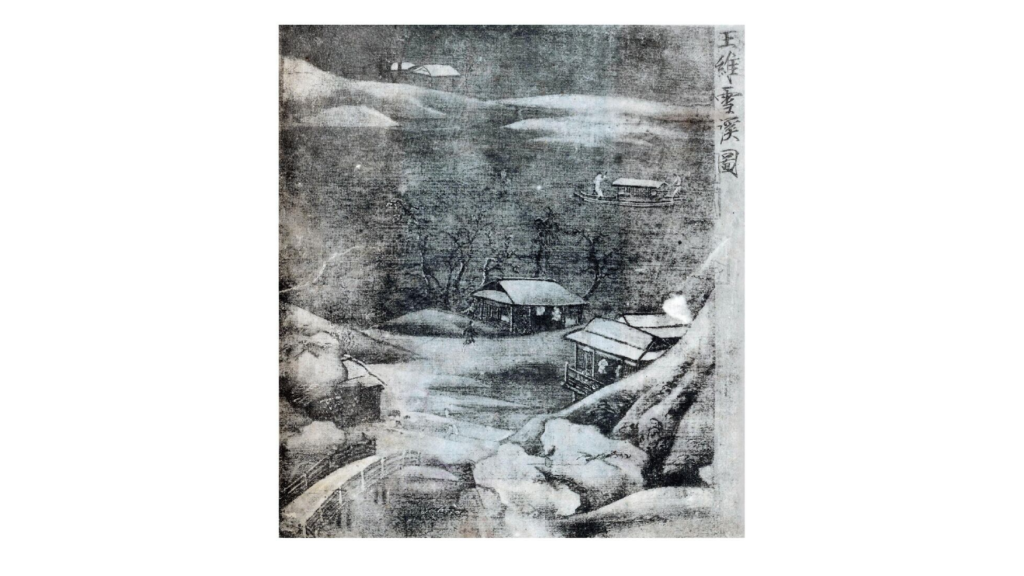
Part of a hand scroll. Ink and color on silk, Formerly Manchu Household Collection, Beijing, now lost.
The post-Tang epoch, the Five dynasties and Ten Kingdoms period 五代十國 (907-979) and the Song dynasty 宋朝 (960-1279), were also characterized by peace and prosperity, and in particular saw the maturity of mountain and water painting, both by painters of court or professionals, who inherited the techniques of blue-green and gold-green mountain and water painting, and from the wenren hua, who carried forward the vision of Wang Wei and the reclusive culture. Although it was an era of peace and political stability, some figures of the artistic panorama chose a life as a hermit, the most famous are the painter and theorist Jing Hao 荆浩 (ca. 850-911),
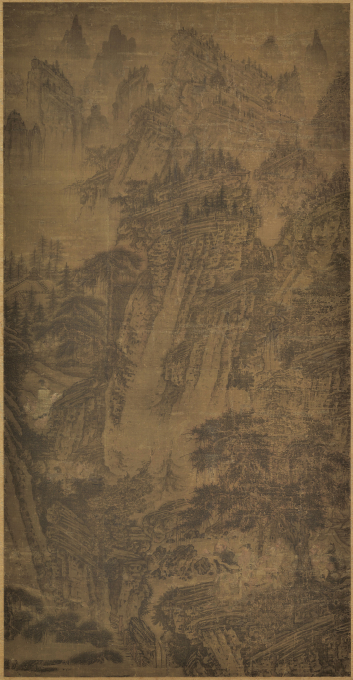
who wrote a milestone in the pictorial theory of mountain and water, the Bifa ji 《笔法记》 who spent his life as a hermit on Mount Taihang Taihang shan 太行山, and Fan Kuan 范宽 (950-1032) that dwelt on Zhongnan mountains Zhoongnan shan 终南山 and Mount Hua Taihua shan 太华山, both were Daoists, who decided to spend their lives in the mountains in order to better understand the secrets and mysteries, bringing the painting of mountains and water at levels never reached before and difficult to reach in the future, also creating a technical and formal apparatus that will be fundamental for the following generations of painters. Guo Xi 郭熙 (ca. 1000-1090), one of the most important figures in the history of Chinese painting, creator of works of the highest level, was the author of Essay on Mountain and Water Painting, Linquan gaozhi 《林泉高致》, a text that is also fundamental for the theoretical structuring of mountain and water painting. In the text Guo Xi among other things defines the importance of mountain and water painting precisely because in a flourishing and stable era it would be a sin to abandon the state and the family, so thanks to painting, both the artist and the observer can experience life far from society, be transported to nature and enjoy solitude.

In the Linquan gaozhi he writes:
It is in human nature to feel the hustle and bustle of society and desire to see spirits and immortals hidden in the clouds. In times of peace, under a good emperor and excellent parents, it would be wrong to leave to be alone, because there are duties and responsibilities that cannot be ignored […]. The dream to retreat in the forests and springs and to find oneself in the company of clouds and mists is always there, but the eye and ear are deprived of it. Now a good hand has reproduced them for us. Without leaving your room you can imagine yourself sitting on the rocks in a gorge and listening to the screaming of monkeys and birdsongs; while the light of the mountains and the colours of the water dazzle the eyes. Isn’t it a joy, a realization of a person’s dream? This is why mountain and water paintings are so in demand. Approaching these paintings without the necessary mood would mean ruining this magnificent view and clouding the refreshing breeze. (Lin Yutang, 1967)
尘嚣缰锁,此人情所常厌也; 烟霞仙圣,此人情所常愿而不得见也。直以太平盛日,君亲之心两隆,苟洁一身,出 处节义斯系,岂仁人高蹈远引,为离世绝俗之行 […]。然则林泉之志,烟霞之 侣,梦寐在焉,耳目断绝。今得妙手郁然出之,不下堂篷,坐穷泉彗星 猿声鸟啼,依约在耳山光水色,混漾夺目。此岂不快人意,实获我心哉?此世之所以贵夫画山之本意也。不此之主而轻心临之,岂不芜杂神观,混浊清风也哉!
Furthermore, Guo Xi in his text re-presents the fisherman and the carpenter as topical figures of the reclusive culture, the one that the noble man seeks through the arts, since he is unable to do so by the secular world:
Why is it that a gentleman loves nature? The reason is that he usually lives in a house and garden, enjoys whistling over rocks and streams, loves to see fishermen, woodcutters and recluse scholars, and enjoys the company of monkeys and cranes. (Lin Yutang, 1967)
君子之所以爱夫山水者,其旨安在?丘园养素,所常处也;泉石啸傲,所常乐也;渔樵隐逸,所常适也;猿鹤飞鸣,所常亲也。
Later on, again in the first chapter of Linquan gaozhi, Guo Xi exposes how the mountain environment should be experienced and lived, he wrote four different ways of relating to it, or sike 四可, four ways of experiencing and expressing it. Guo Xi writes:
It has been truly said, that among the landscapes there are those fit to walk through, those fit to contemplate, those fit to ramble in and those fit to live in. All pictures may reach these standards and enter the category of the wonderful; but those fit to walk through or to contemplate are not equal to those fit to ramble in or to live in it. (Siren, 1963)
世之笃论,谓山水有可行者,有可望者,有可游者,有可居者。画凡至此,皆入妙品。但可行可望不如可居可游之为得。
Those works that are able to give a sensation of traveling keyou 可游 or that of living in the mountains keju 可居, are the better works, since they are able to communicate the ways of experiencing the natural environment of the reclusive culture, which is the most intimate, in-depth and engaging way, which leads to establishing a close relationship with the mountains and the waters. It should be remembered that the importance and the pleasure of traveling in the mountains is a concept already expressed by Zong Bing, who had embraced the hermit lifestyle. In the Hermits, Yimin si, section of the Taiping Yulan (《四部 丛刊三编》 本 《太平御览》 : 逸民四) these words are reported: “Every time I visit the mountains and waters, I forget to return “, 每游山水, 往辄忘归.
Revival of the reclusive culture in Yuan dynasty
At the end of the Song dynasty, a new period of instability begins, for about a century the Chinese empire was led by the Mongolian populations, who engaged in a bloody struggle for power. Chinese intellectuals and writers, on the one hand, felt culturally uprooted because a foreign population was at the head of their civilization and therefore began to no longer appreciate political participation, both for ideological factors and for the material risks that were run in the hold official positions. Once again, the response of the Chinese intelligentsia to the socio-political crisis was the choice of a secluded life away from the active society. In the Yuan era 元朝 (1271-1368) the painting of mountain and water had reached its splendour, the literate artists had imposed themselves on the Chinese cultural landscape, naturally the turbulent historical moment had awakened hermit desires, the union of these elements led to the creation of a large amount of works that refer to the reclusive culture, as the painters chose a hermit lifestyle. This lifestyle was no longer as easily attainable as it was during the Wei-Jin period. In the thirteenth and fourteenth centuries China was much more urbanized than during the Wei-Jin, and leaving the secular world was a more difficult choice to make. However, the painters of the Yuan era, even if they were unable to have a completely secluded lifestyle, strongly used the types and ideas of the reclusive culture. The four greatest mountain and water painters of the Yuan dynasty, yuan sijia 元四家, were all four literati and more or less followers of Daoism, all chose a secluded lifestyle, trying as much as possible to keep away from the world secular. These four great artists were Huang Gongwang 黄公望 (1269-1358), Wu Zhen 吴镇 (1280-1354), Wang Meng 王蒙 (1308-1385), Ni Zan 倪瓒 (1301-1374), and , who through their works re-proposed themes and topoi of the reclusive culture, such as the fisherman, became Wu Zhen’s favorite theme, as for the woodcutters, Wang Meng signed himself as the “woodcutter of Huanghe shan” 黄鹤山樵, where he spent his years as a hermit. The lonely trees and thatched cottages xushe 芧舍, traditionally were narrative topoi that recalled the hermits world, and are often found in the works of Ni Zan, who besides being a great painter was an excellent calligrapher and poet, in the full spirit of the wenren hua. Also in Huang Gongwang’s works we find all the themes of reclusive culture, in his famous Dwelling in the Fu Chun Mountains, Fuchunshan ju tu 《富春山居图-无用师全卷》 which is a work that is the result of years of study and four of painting of the area in which Huang Gongwang had retired, the painting represents the mountain and river area of Fuchun mountain, the use of ink and brush reflects the mental state of tranquillity reached by the painter thanks to a life in solitude.
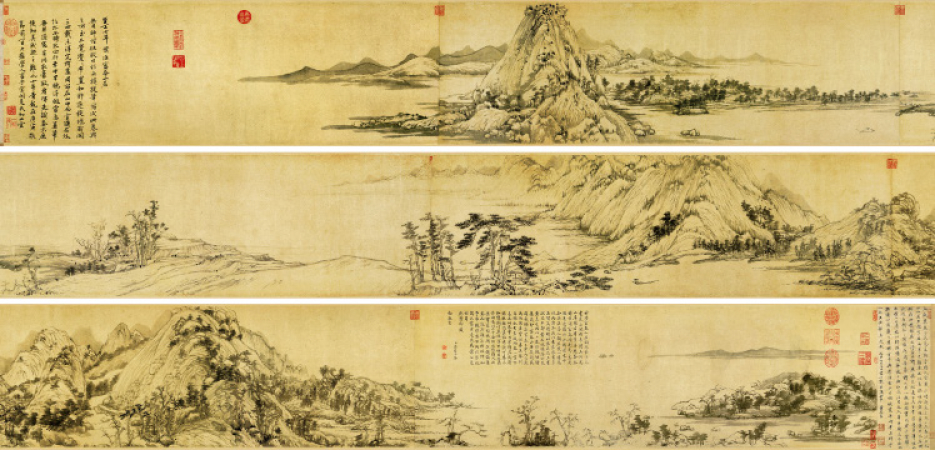
In the painting it is possible to find all the topical elements of the reclusive culture, the fishermen, a thatched cottage with a man of letters intent on admiring the landscape. The lightness of the lines, the wide empty spaces and the delicacy of the ink communicates a feeling of peace and silence, expressing the artist inner world. The observation of this work puts us in the state of the hermit, making us relive his experiences, transporting us between the mountains and the waters, as indicated by Zong Bing or Guo Xi.
Conclusion
We see how reclusive culture is extremely important and present in the Chinese cultural landscape, at least since the Spring and Autumn period, where the figure of the Chinese hermit is structured, who sees his adversity to government and public life as the first fundamental characteristic. Therefore automatically, everything that entails, such as social utilitarianism, the thirst for power and wealth, and all elements that ultimately lead to a life of trouble strays from the main purpose, which is essentially the pursuit of happiness. The aversion to social life is clear in moments of political instability, where the reclusive culture becomes a sort of protest of the intellectual towards the system, literate artists who from the period of the Wei-Jin lived far from the secular world, but did not live in complete loneliness, indeed they almost created a new cultural network alternative to that of the governments, which opposes the struggles for power and materialism, a cultural network that is very rich and dynamic, much more dynamic than the one that gravitates around the secular world, which when shaken by instability and violence, becomes arid and monolithic. This is even more evident in the last period taken into consideration, namely that of the Yuan dynasty, where a high level of social evolution made it more difficult to reach the status of the hermit, a factor that gave great strength to the hermit topoi born during the Chinese cultural history and were used by writers as symbols against the political situation of the time to spread the conceptions and ideas of reclusive culture. The case of mountain and water painting is of particular interest, since it sees the birth of a genre and its evolution within this cultural class, from which it took its theoretical-philosophical bases and carried them forward to the contemporary age, profoundly influencing a class of intellectuals, the wenren, who have written a fundamental part of the cultural and artistic history of China, and who continue to do so in the contemporary world, clearly adapting to the times, but pursuing ideals that perhaps have never been more vital than now. The search for communion and balance with nature and attention to the feelings of the individual is of utmost importance. Therefore, we need a strong sense of humanity and the abandonment of utilitarianism and materialism, and the stigmatism of the race for power, the accumulation of riches, which are the root causes of what’s destroying the world we live in.
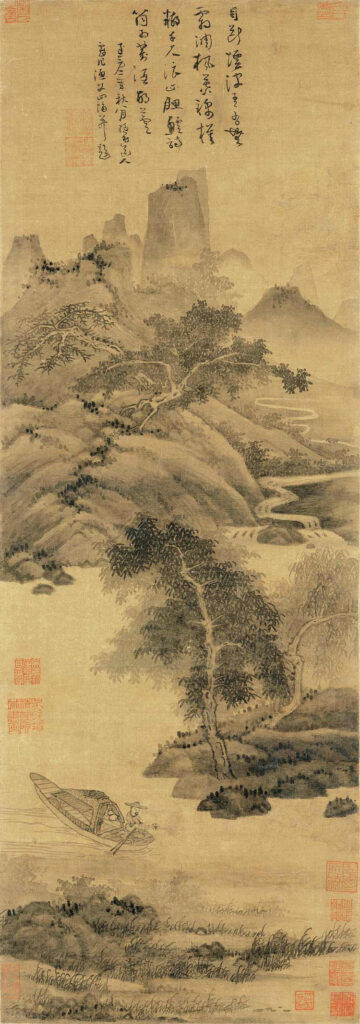
Hanging scroll ink on silk 84.7×29.7cm,Collection of the Palace Museum
Wu Zhen’s Fisherman is one of the most typical mountain and water painting with the theme of “fishing and reclusing”
渔隐. There are many pictures of Fisherman handed down by Wu Zhen. The picture depicts the scenery of the south Vhina (Jiangnan) water areas, bushes and trees, a fisherman rides a small boat among the lakes and rivers. In the whole picture, the ink tone is lush, and the mountains, rocks, trees, branches and leaves are characterized by the alternating use of the ink tones in order to express the hierarchical relationship and highlight the main objects. Variety of brushwork, texture strokes, the lines and the dots, can show the author’s superb control ability. The secluded and quiet mood between the lakes and mountains is vividly on the paper, giving a sense of being far away from the mundane.
Read the article from the magazine
